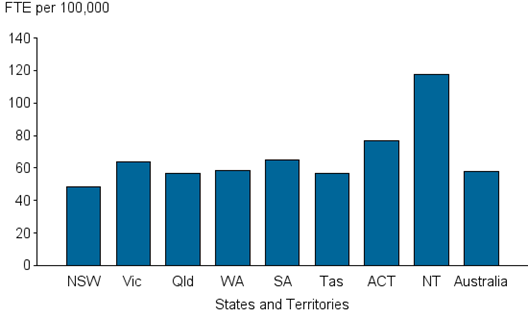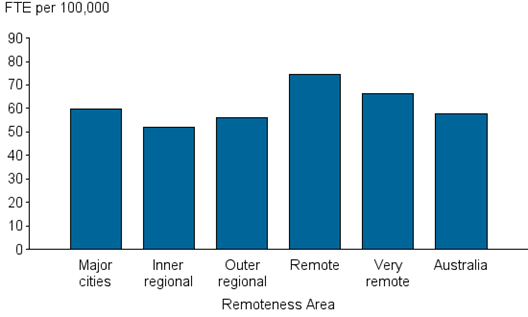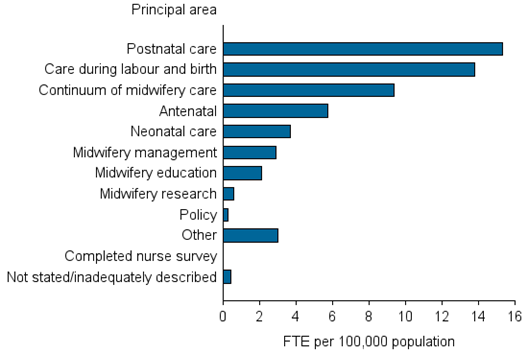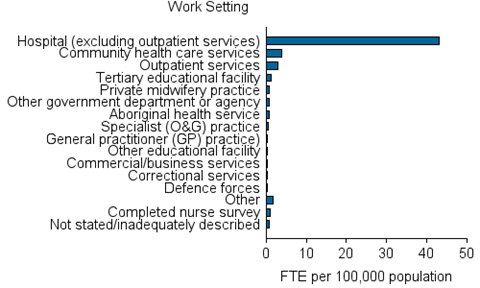Focus on midwives
Midwives need to be registered to be employed in Australia, however not all those who are registered are employed. There has been a large decrease in the number of registered midwives in Australia, falling from 52,273 in 2009 to 32,651 in 2015. This is related to the introduction of new ‘recency of practice’ standards that mean midwives must be actively working in midwifery to maintain their registration. To ensure this doesn’t confound the data, the data presented here focuses only on those registered midwives who reported working in midwifery (referred to as ‘employed midwives’). For more information about this and other changes in the workforce data see the Data quality statement.
In 2015, there were 28,211 registered midwives who reported working some hours in either midwifery or nursing in the week prior to completing the workforce survey, down slightly from 28,756 in 2014. Of these, 23,801 reported having worked hours in midwifery, about the same as in 2014. On average, employed midwives worked 21.9 hours per week in midwifery. This excluded hours that they may have worked in nursing. This equated to a full time equivalent (FTE) rate of 57.6 employed midwives per 100,000 people, down from 61.0 in 2014.
In 2015, almost all of employed midwives were female (98.6%) and 88.5% held a registered nurse registration. The average age of employed midwives was 47.9 years and 52.3% were aged 50 and over.
Attendance at births
Of the 28,211 registered midwives employed in midwifery or nursing in 2015, 10,960 (38.8%) reported attending a birth as the primary midwife in the past 12 months. Of these:
- 10,714 (97.8%) indicated they attended a birth in a hospital as the primary midwife.
- 548 (5.0%) indicated they attended a birth in a birth centre as the primary midwife.
- 241 (2.2%) indicated they attended a birth in a home as the primary midwife.
- 156 (1.4%) indicated they attended a birth in another location as the primary midwife.
States and territories
In 2015, the overall supply of employed midwives varied across the states and territories, from 48.4 FTE per 100,000 population in New South Wales to a high of 113.2 in the Northern Territory.
The average age of midwives varied little between jurisdictions, from 47.2 years in Victoria to 48.8 years in South Australia.
Employed midwives working in midwifery in the Australian Capital Territory worked the most average weekly hours (23.0). South Australia reported working the least average weekly hours (20.5).
Figure 1: Employed midwives: states and territories, FTE rate, 2015

Notes
- ‘Employed midwives’ is defined as registered midwives who reported working any hours in midwifery in the week before the survey.
- Derived from ‘state and territory of main job’ where available; otherwise, ‘state and territory of principal practice’ is used as a proxy. If principal practice details unavailable, ‘state and territory of residence’ is used. Records with no information on all three locations are coded to ‘not stated’.
- Full-time equivalent (FTE) per 100,000 population. FTE is based on total weekly hours worked in midwifery.
Source: AIHW NHWDS.
Remoteness areas
In 2015, the overall supply of employed midwives varied across remoteness areas, from 51.9 FTE per 100,000 population in Inner regional areas to a high of 74.4 in Remote areas.
In 2015 the average age of employed midwives who reported working in a remoteness area was greatest in Very remote areas (51.7 years) and lowest in Major cities (47.6 years). Very remote areas also had the greatest proportion of midwives aged 50 and over (68.4%). Employed midwives in Major cities reported working the most average weekly hours (22.8). Very remote areas reported working the least average weekly hours (18.0).
Figure 2: Employed midwives: remoteness area, FTE rate, 2015

Notes
- ‘Employed midwives’ is defined as registered midwives who reported working any hours in midwifery in the week before the survey.
- Derived from ‘remoteness area of main job’ where available; otherwise, ‘remoteness area of principal practice’ is used as a proxy. If principal practice details unavailable, ‘remoteness area of residence’ is used. Records with no information on all three locations are coded to ‘not stated’.
- Full-time equivalent (FTE) per 100,000 population. FTE is based on total weekly hours worked in midwifery.
- Very remote areas includes Migratory areas.
Source: AIHW NHWDS.
Role in midwifery
In 2015, 88.4% of employed midwives in Australia were working as clinicians (21,050). Of the non-clinical workforce, ‘administrator’ was the largest group (1,216 or 5.1%), followed by ‘teacher/educator’ (1,092 or 4.6%). Clinicians reported working the most average weekly hours in midwifery (22.3).
| Principal role | Number | Male(per cent) | Average age (years) | Aged 50 and over (per cent) | Average weekly midwifery hours(b) |
|---|---|---|---|---|---|
| Clinician(c) | 21,050 | 1.2 | 47.4 | 50.3 | 22.3 |
| Administrator | 1,216 | 3.9 | 53.4 | 74.8 | 18.2 |
| Teacher/educator | 1,092 | 2.3 | 50.5 | 60.7 | 19.0 |
| Researcher | 300 | 1.0 | 51.5 | 65.3 | 21.7 |
| Other | 143 | 4.2 | 51.9 | 68.5 | 20.0 |
| Total | 23,801 | 1.4 | 47.9 | 52.3 | 21.9 |
- ‘Employed midwives’ is defined as registered midwives who reported working any hours in midwifery in the week before the survey.
- Hours worked as a midwife only.
- A clinician is a person who spends the majority of his or her time working in the area of clinical practice.
Source: AIHW NHWDS.
Area of midwifery
In 2015, the ‘principal area of main job’ of employed midwives with the highest FTE rate was postnatal care (15.2 FTE per 100,000 population).
Figure 3: Employed midwives: principal area of main job, FTE rate, 2015

Notes
- ‘Employed midwives’ is defined as registered midwives who reported working any hours in midwifery in the week before the survey.
- ‘Completed nurse survey’ refers to those nurses who completed a nurse survey form instead of a midwife survey form. The nurse survey consists of different categories of ‘principal area of main job’, and their responses have been grouped together here. For nurse survey categories of ‘principal area of main job’, please refer to Work characteristics of nurses and midwives.
- Full-time equivalent (FTE) per 100,000 population. FTE is based on total weekly hours worked in midwifery.
Source: AIHW NHWDS.
Type of work setting
In 2015, by far the work setting of employed midwives with the highest FTE rate was hospitals (excluding outpatient services) (43.1 FTE per 100,000 population).
Figure 4: Employed midwives: work setting of main job, FTE rate, 2015

Notes
- ‘Employed midwives’ is defined as registered midwives who reported working any hours in midwifery in the week before the survey.
- ‘Completed nurse survey’ refers to those nurses who completed a nurse survey form instead of a midwife survey form. The nurse survey consists of different categories of ‘principal area of main job’, and their responses have been grouped together here. For nurse survey categories of ‘principal area of main job’, please refer to Work characteristics of nurses and midwives.
- Full-time equivalent (FTE) per 100,000 population. FTE is based on total weekly hours worked in midwifery.
Source: AIHW NHWDS.
Country of initial qualification
Of employed midwives, 20,409 received their initial midwifery qualification in Australia (85.7%). England was the next most common country of initial qualification (1,714 or 7.2%).
Aboriginal and Torres Strait Islander midwives
In 2015, there were 230 midwives employed in Australia who identified as an Aboriginal and/or Torres Strait Islander. This represents 1.0% of all employed midwives who provided their Indigenous status.


